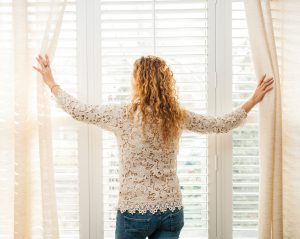
In the cooler fall and winter seasons, open the drapes on your south-facing windows during the day. This will allow sunlight to heat your home naturally. Be sure to close them at night to help keep out any cold air. Photo: GETTY IMAGES/ELENATHEWISE
While saving money through greater energy efficiency may be a year-round objective for many members, the way to achieve this goal will vary by season. There are a number of factors that impact energy efficiency, including weather, the age and condition of the home, and desired comfort levels. During fall and winter months, when the outdoor temperature is chilly, consumers desire a warm home and seek to keep the cold air out. Conversely, in the spring and summer, the focus is on keeping the hot air from infiltrating cool abodes.
Fall and winter: Keeping heat in
To maintain a warm indoor environment in chillier weather, there are simple steps you can take to increase energy efficiency. Fall is a great time to schedule a service appointment for your heating system to ensure it is operating at an optimal level. Examine seals on doors and windows to check for air leaks. Caulk and weatherstrip as needed to seal in warm air and energy savings. Similarly, examine outlets for air leaks, and where necessary, install gaskets around the outlets to prevent drafts. During the day, open curtains or drapes on south-facing windows to enable sunlight to heat your home naturally. Close curtains or drapes at night for an added layer of window insulation. If your home is heated using a geothermal or air-source heat pump, take caution when adjusting your thermostat to avoid your backup system from running.
Spring and summer: keeping you cool
During warmer months, energy savings and efficiency will require different measures, many of which are inexpensive. If you live in a climate that is cool, open your windows in the evening and turn off your cooling system while sleeping. In the morning, shut the windows and blinds to hold in the cool air. Where practical, plant trees and shrubs that provide shade in warm months and sunlight in winter. In addition to the aesthetic value, well-placed trees can take heat gain from the sun and provide needed shade by creating a canopy for the house.
In extremely hot weather, your cooling system works harder to close the gap between the high outdoor temperature and the cool indoor thermostat setting. To lessen the difference in temperature between the two, and to lower cooling costs, set the thermostat as high as you can while maintaining your comfort level. Moreover, using a ceiling fan in conjunction with your air conditioning can allow you to increase the thermostat setting to approximately four degrees with no reduction in comfort levels.
During the hottest months, it’s all the more critical to replace any remaining incandescent bulbs with LED bulbs. The heat from the old bulbs impacts energy use and creates wasteful and unwanted heat. Employ a programmable thermostat to adjust the settings a few degrees higher when no one is home or your family is sleeping.
If you have questions about how to make your home more energy efficient, or have concerns about your current energy use, call KVREMC Energy Advisor Darrell Marks and schedule a free energy assessment.



